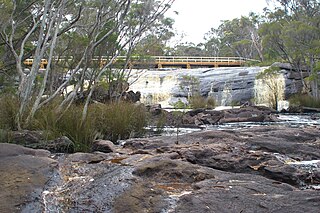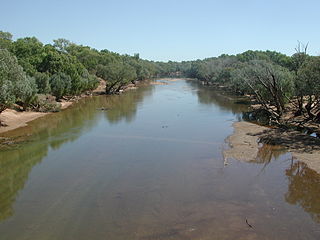
The Horizontal Falls, or Horizontal Waterfalls, nicknamed the "Horries" and known as Garaanngaddim by the local Indigenous people, are an unusual natural phenomenon on the coast of the Kimberley region in Western Australia, where tidal flows cause waterfalls on the ebb and flow of each tide. The Lalang-garram / Horizontal Falls Marine Park is a protected area covering the falls and wider area.

The Peel-Harvey Estuarine System is a natural estuarine system that lies roughly parallel to the coast of Western Australia and south of the town of Mandurah.

Nornalup Inlet is an estuarine body of water on the south coast of the South West of Australia, approximately 450 km (280 mi) from Perth.

The Roper River is a large perennial river located in the Katherine region of the Northern Territory of Australia.

Deep River is a river located in the Great Southern region of Western Australia.
Charnley River is a river in the Kimberley region of Western Australia.

Isdell River is a river in the Kimberley region of Western Australia, named in 1898 by explorer Frank Hann after James Isdell, who was prominent in the region and later served as a member of parliament.

Camden Sound is a relatively wide body of water in the Indian Ocean located in the Kimberley region of Western Australia. The Sound is bounded by the Bonaparte Archipelago to the north-east, the Buccaneer Archipelago to the south-west, and Montgomery Reef to the south.
The Sale River is a river in the Kimberley region of Western Australia. The river was seen and named on 9 June 1865 by an expedition from the short-lived Camden Harbor settlement searching for pastoral land. The expedition comprised Alexander McRae, Trevarton Sholl, PC William Gee, John Stainer and an Aboriginal constable named Billy.
The McRae River is a river in the Kimberley region of Western Australia.

Montgomery Reef is a reef off the Kimberley coast of Western Australia. It is situated at the south western end of Camden Sound and surrounds Yawajaba (Montgomery) Island. With its total area of 400 square kilometres (154 sq mi), it is the world's largest inshore reef. The nearest populated place is Bardi, which is approximately 130 kilometres (81 mi) to the south west.

Yeeda Station is a pastoral lease that operates as a cattle station in the Kimberley region of Western Australia.

Mount Hart Station, commonly referred to as Mount Hart, is a defunct pastoral lease that once operated as a cattle station in Western Australia. The lands are part of a conservation area and the homestead operates as a wilderness lodge for tourists.
Charnley River–Artesian Range Wildlife Sanctuary is a protected area covering about 3,000 square kilometres (1,200 sq mi) in the Kimberley region of Western Australia. It is situated about 205 kilometres (127 mi) east of Derby and 287 kilometres (178 mi) north west of Halls Creek, and is accessed via the Gibb River Road. It is named after the Charnley River that flows through the property.
Mount House Station, commonly referred to as Mount House, is a pastoral lease that operates as a cattle station in Western Australia.
Kimberley Downs Station, commonly referred to as Kimberley Downs, is a pastoral lease that operates as a cattle station in Western Australia.
Napier Downs Station, commonly referred to as Napier Downs, is a pastoral lease that operates as a cattle station in the Kimberley region in Western Australia.
Camden Harbour was a short-lived settlement in the Kimberley region of Western Australia in 1864–1865 that was situated in the larger Camden Sound. The settlement was also known as the Camden Harbour Expedition, as well as the Government Camp.
The Ngarinyin or Ngarinjin are an Aboriginal Australian people of the Kimberley region of Western Australia. Their language, Ngarinyin, is also known as Ungarinyin. When referring to their traditional lands, they refer to themselves as Wilinggin people.
Collier Bay is a bay in the Indian Ocean, located on the Kimberley coast in the north-west of Western Australia.









